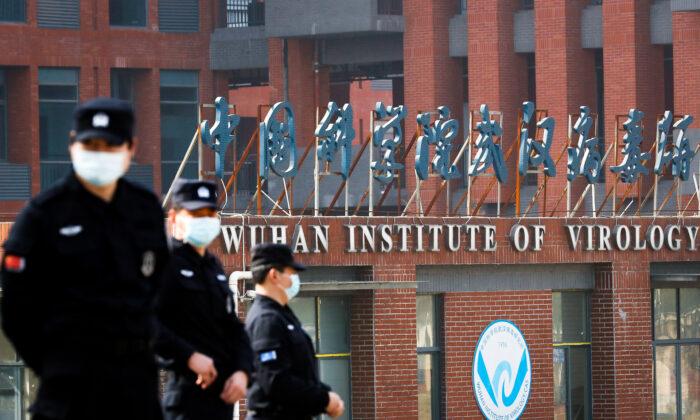Commentary
Recent reports from major media organizations
claim that new evidence points to raccoon dogs at the Wuhan Seafood Market as the origin of COVID-19. The story was first
reported by The Atlantic, which claimed that the raccoon dog discovery was “the strongest evidence yet that an animal started the pandemic.” The New York Times scrambled to put out a same-day
story of their own, titled “New Data Links Pandemic’s Origins to Raccoon Dogs at Wuhan Market.”
Science Magazine, the media outlet that helped Dr. Anthony Fauci seed the natural origin narrative for COVID-19’s emergence, also put out an urgent same-day
news story, claiming that “Unearthed genetic sequences from China market may point to animal origin of COVID-19.”
The problem with the reporting is that the raccoon dog narrative was entirely made up out of thin air and the media organizations that reported it knew that to be the case. There was no new evidence. Additionally, the scientists involved in pushing the story were known to be close associates of Fauci and have a history of pushing false narratives.
The raccoon dog story is closely linked to a private teleconference that Fauci organized on Feb. 1, 2020, during which the elevating of the natural origin narrative and suppression of the lab leak theory for COVID-19’s emergence was discussed. It was at that teleconference that Fauci
commissioned a paper from four scientists who were in
attendance: Kristian Andersen, Edward Holmes, Robert Garry, and Andrew Rambaut.
The group, which is now also behind the raccoon dog story, immediately set about writing the fraudulent
Proximal Origin paper as a cudgel that Fauci could use against anyone who deigned to question the natural origin narrative. In fact, when President Donald Trump questioned the narrative at an April 17, 2020, White House news conference, Fauci
invoked the Proximal Origin paper without acknowledging his role in creating it. Fauci even pretended to not know who the authors of the paper were.
The problem for Fauci and the Proximal Origin authors was that their narrative was entirely contrived, which meant that the group had to make up a plausible-sounding story. The story that they came up with was that pangolins were responsible for the outbreak. Pangolins are scaly, anteater-type mammals that have been known to be used in traditional Chinese medicine. There’s no evidence that pangolins played any role in the pandemic, nor that they were sold at the Wuhan Seafood Market, where Fauci’s group wanted to place the origin of the pandemic. In addition, all animals at the market tested
negative for COVID-19.
Notwithstanding these problems, Fauci’s group initially hung on to its pangolin narrative. Then, in the summer of 2022, the group co-published another
paper, this time raising the possibility that raccoon dogs were responsible for the pandemic. As evidence, the group included a photo of raccoon dogs that a member of the group, Edward Holmes, had allegedly taken at the Wuhan Seafood Market in 2014. The group didn’t explain how the presence of raccoon dogs in 2014 led to an outbreak six years later. Notwithstanding, the idea that raccoon dogs might have been responsible was seeded.
Then, earlier this month, in what superficially appears to have been a huge coincidence,
Florence Débarre, a French scientist who’s associated with Fauci’s group and is known for pushing the natural origin narrative on Twitter, suddenly discovered raccoon dog DNA in a data sample uploaded by Chinese scientists who were themselves studying the Wuhan Seafood Market.
Incredibly, the data that Débarre had apparently stumbled upon included raccoon dog DNA, which, even more incredibly, came from
Stall 29, the same spot where Holmes had snapped the photo of raccoon dogs nearly a decade earlier.
Débarre quickly teamed up with Fauci’s group of scientists to promote the raccoon dog narrative. Notably, the same four scientists—Andersen, Holmes, Garry, and Rambaut—who led Fauci’s Feb 1, 2020, secret teleconference and who also led the Proximal Origin effort, are now leading the raccoon dog story.
That story is that raccoon dogs were likely responsible for the pandemic. The only evidence for their claim, obtained from the mysterious data set Débarre so fortuitously found online, is that raccoon dog DNA was found at the market, along with DNA from many other animals, DNA from humans, and RNA from COVID-19. However, none of these claims are new. Further, even if the claims are correct, they’re completely meaningless. We already knew that humans, animals, and COVID-19 were at the market. There’s no suggestion that any raccoon dogs were infected because, as mentioned before, all animals at the market tested
negative for COVID-19.
It’s as if Fauci’s group discovered that water is wet. Notwithstanding the frivolous nature of their supposed discovery, the group used multiple taxpayer
grants to fund their latest efforts.
Corporate media apparently didn’t see any problem with this narrative, nor with the sources for the story. The Atlantic, The New York Times, and Science Magazine all published the story without any substantiation, other than the say-so of a group of conflicted scientists who they knew were deeply involved with Fauci’s origin cover-up, as well as having previously pushed the fake pangolin story.
None of the media outlets mentioned any conflicts of interest, nor the history of false claims from their sources.
However, perhaps surprisingly, this time Fauci’s group didn’t have it all their own way. The Atlantic, which first broke the false story, was widely
lampooned for its laughable “animal DNA found at animal market” narrative. Even the World Health Organization was skeptical of the group’s claims and called for the data to be
released.
This put Fauci’s group under pressure to produce something more than mere verbal claims. They finally put out a
quasi-paper last week. In a highly unusual move, they didn’t publish a preprint, which is the normal way that science papers first get published while they await peer review. Instead, they posted their report on Zenodo, which is an open repository where any scientist can post their material.
Astonishingly, the authors conceded that they won’t even try to get their quasi-paper published in a journal. Again, this is highly unusual in science circles and serves as a testament to how little confidence they have in their own statements.
Through a statement that accompanied the quasi-paper, we also found out how Fauci’s group obtained the raccoon dog data. That story is a scandal in itself.
Early last year, a group of Chinese scientists published a
preprint that showed that the pandemic didn’t start at the Wuhan Seafood Market. They say that, instead, the market was the likely location of a human-to-human superspreader event. This is the opposite of Fauci’s group’s narrative.
The Chinese paper has been held up in peer review for more than a year and, as part of that process, the Chinese scientists were asked to upload their data into a repository called
GISAID, the Global Initiative on Sharing Avian Influenza Data, for verification.
It was on GISAID, supposedly by sheer coincidence, that Débarre claims to have found the raccoon dog data, which she then immediately shared with Fauci’s group. The public hasn’t seen that data, and it isn’t known with certainty what it says. However, based on the Chinese preprint from last year, the data presumably show that COVID-19, humans, and animals were at the market but that no animals were infected.
Under GISAID rules, the repository is meant as a forum to share data for purposes such as verification. It isn’t allowed to “scoop” data uploaders. In other words, users can’t publish their own papers based on other people’s data while those other people are still waiting for their own publications to be approved.
Yet that’s exactly what Fauci’s scientists did, presumably because they wanted to preemptively shape the narrative in the opposite direction from what the Chinese paper is likely going to say. It’s also possible that Débarre or someone in Fauci’s Proximal Origin group was tipped off to the fact that the Chinese scientist had been asked to upload the data.
As a consequence of their actions, GISAID immediately
banned Fauci’s group from the platform. This is highly unusual, tantamount to a student being banned from the school library. After much protesting, the group has now been allowed back
temporarily while GISAID completes its investigation.
These new revelations also allow us to understand not only why the data appeared on GISAID in the first place but why it was taken down. Contrary to The New York Times’
inference that the Chinese scientists were trying to hide something, the truth is that the Chinese scientists had been unethically scooped and had no choice but to take down their data, which was being misused.
As to why the Chinese scientists are pointing the blame away from the Wuhan Seafood Market, it has been the
Chinese line for some time that the virus didn’t come out of the market. Chinese officials have instead offered explanations such as imported
frozen food and have even tried to
pin the blame on U.S. labs, such as the U.S. Army’s Fort Detrick.
And as for the corporate media, they still haven’t issued any corrections.
Views expressed in this article are opinions of the author and do not necessarily reflect the views of The Epoch Times.







